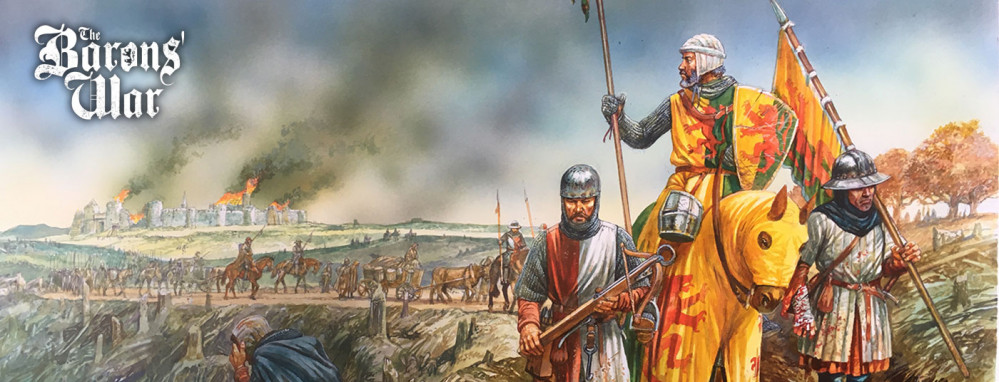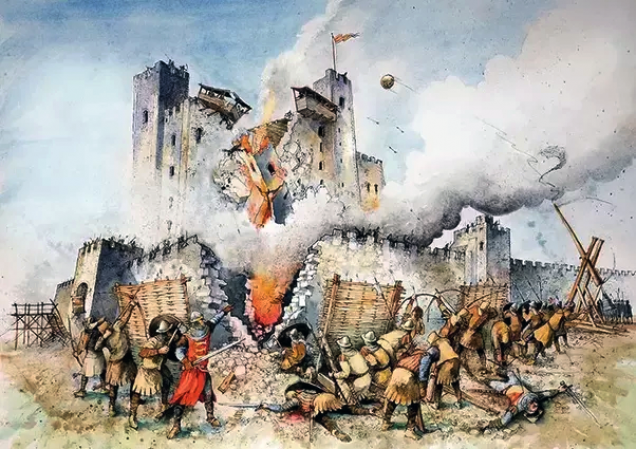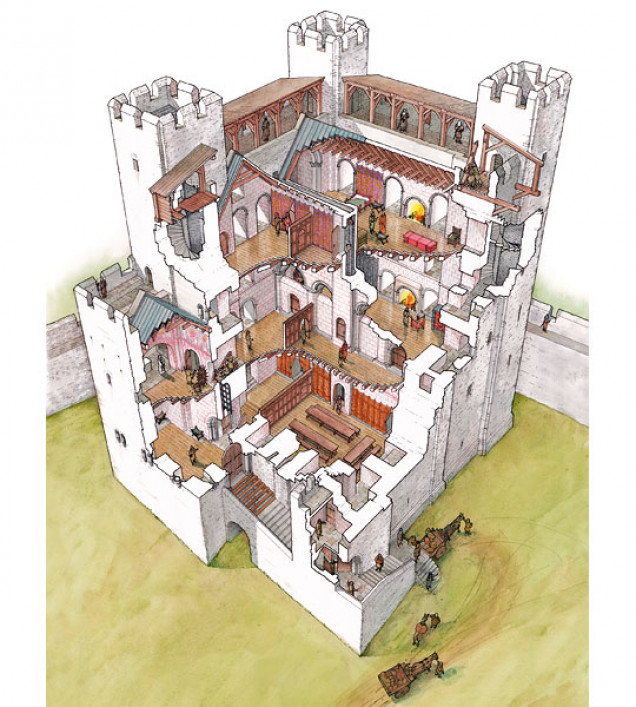
PanzerKaput Goes To Barons' War
Siege of Rochester Castle I
On 11 October 1215, a crack troop of a hundred knights arrived at the gates of Rochester Castle and demanded to be admitted. The constable of the castle, Sir Reginald de Cornhill, did not hesitate, for he had been expecting them. The drawbridge was lowered, the doors swung open, and the horsemen swept inside.
These men were rebels, come into Kent on a highly dangerous mission. Earlier in the year, along with scores of other noblemen, they had seized control of London in defiance of their king. In recent days, however, they had started to sense that the tide was turning against them, and had therefore decided to take action. Selected by their fellows as the bravest and most skilled in arms, they had ridden south-east to open up a second front. If London was to hold out, they knew they had to distract the king, and draw his fire away from the capital.
Their plan, in this respect, was brilliantly successful. Two days later, a royal army drew up outside the walls of Rochester. King John had arrived.
John was the youngest son of Henry II, and the runt of his father’s litter. He is familiar to all of us as the bad guy from the Robin Hood stories – the snivelling villain who betrayed his elder brother, ‘Good’ King Richard the Lionheart, and made a grab for the English throne. It will hardly surprise most people to learn that this picture of John is a caricature – the Robin Hood legends originated long after the king was dead. Nevertheless, even if we scrape off all the mud that has been flung at John over the centuries, he still emerges as a highly unpleasant individual, and a man unsuited to the business of ruling. Contemporaries might not have recognized the hideous, depraved monster of legend, but they would have acknowledged the basic truth of the matter – John was a Bad King.
To find out what people really thought about King John, we have to leave the stories of Robin Hood, and turn instead to another piece of writing, very different but no less famous. In 1215, shortly before they set off to seize Rochester Castle, John’s enemies compiled a list of complaints about him, and presented it to the king in the hope of persuading him to behave better in the future. The list was drawn up in the form of a charter and, because it was so long, the charter itself was very big. People soon started referring to it simply as the Big Charter; or, in Latin, Magna Carta.
So, by looking at Magna Carta, we can work out why people were annoyed with King John. What aggravated them most, it seems, was the way in which he constantly helped himself to their cash; the first clauses of the Charter are all concerned with limiting the king’s ability to extort money. In 1204, five years into his reign, John had suffered a major military and political disaster when he lost Normandy, Anjou and Poitou to the king of France. These provinces had formed the heart of John’s empire, and trying to get them back had kept him busy for the past ten years. Ultimately, however, by plotting his recovery, John was paving the way to his own downfall. The cost of building an alliance to strike back against the French king was enormous, especially because it was John’s misfortune to rule at a time when inflation was causing prices (of mercenaries, for example) to soar. With increasing frequency, John passed the costs on to his English subjects, imposing ever greater and more frequent taxes, fining them large sums of money for trivial offences, and demanding huge amounts of cash in return for nothing more than his grace and favour. Very quickly, John managed to create a situation where the people who didn’t want him in charge outnumbered those who did – a dangerous scenario for any political leader.
In some respects, however, the rebellion that the king faced in 1215 was not entirely his own fault. Both his father and his brother had governed England in much the same fashion, expanding their power at the expense of the power of their barons. One very visible way of measuring their success is by looking at their castles. At the start of Henry II’s reign in 1154, only around 20 per cent of all castles in the country were royal. The two decades before Henry’s accession had seen a proliferation of private castles (mostly motte and baileys) built without the king’s consent. One of Henry’s first actions as king was to order (and, where necessary, to compel) the destruction of such fortifications. Moreover, Henry and his sons, as we have seen, built new castles – big, impressive stone towers like Newcastle, Scarborough, Orford, and Odiham. By the time of John’s death, the ratio of royal castles to baronial ones had altered drastically; almost half the castles in England were in royal hands. Castles, therefore, provide a good index of the king’s power against the power of his barons.
It is evident that the rebels brought long-term grievances such as this to the negotiating table in 1215, because John tried to address them in Magna Carta.
‘If anyone has been dispossessed without legal judgement from his lands or his castles by us,’ the king said, ‘we will immediately restore them to him.’
But John went on to add that his subjects should make allowances for anyone who had been similarly dispossessed ‘by King Henry our father, or King Richard our brother’. Such hair-splitting, however, ignored the basic truth of the matter, which was that Henry and Richard were simply better kings than John. They were skilled warriors, while he was condemned for his cowardice. Although he proved a capable administrator (John could be dynamic and efficient when it came to collecting taxes), he was a bad manager, unfit to command the loyalties of his leading subjects, unable to check or channel their ambitions, and uneven in his distribution of rewards. Most of all, John was just an unpleasant guy. He sniggered when people talked to him. He didn’t keep his word. He was tight-fisted and untrusting. He even seduced the wives and daughters of some of his barons. Henry and Richard might have acted unfairly from time to time, but overall people liked them; almost nobody liked John.
It was John’s personality, in the end, that doomed Magna Carta to failure. There was little point in persuading John to make such an elaborate promise, because he was bound to try and wriggle out of it. Sure enough, no sooner had negotiations ended than the king was writing to the Pope, explaining how the Charter had been forced out of him, and asking for it to be condemned. By the time the Pope wrote back, however, John’s opponents had already worked out for themselves that Magna Carta was not worth the parchment it was written on. The king would never keep his promises, and they had no way of compelling him to do so. They too abandoned the Charter as a solution, in favour of the much simpler plan of offering John’s crown to someone else. By the autumn of that year, both the king and the rebels were openly preparing for war.
This war was eventually fought right across the country. The South-East of England, however, and especially Kent, was the most important arena of conflict, because both parties were seeking assistance from the Continent. The rebels, for their part, had decided to offer the crown of England to Prince Louis, eldest son of the king of France. They had already made overtures to him in the course of the summer, and were hoping he would soon arrive and stake his claim in person, bringing with him much-needed reinforcements. John, meanwhile, was also looking across the Channel for help, but in his case from Flemish mercenaries. The king had recently despatched his recruiting agents overseas, and was hovering anxiously on the south coast, trying to secure the loyalty of the Channel ports, and waiting for his soldiers of fortune to arrive.
In such circumstances, control of Rochester Castle, which stood at the point where the main road to London crossed the River Medway, became all-important. John understood this as well as anyone, and for this reason had been trying to get his hands on the castle since the start of May, when the rebellion against him had first raised its head. The king had already written to the Archbishop of Cantebury twice, asking, in the nicest possible way, if he would mind instructing his constable to surrender the great tower into the hands of royal representatives. Both times, however, the request fell on deaf ears. The archbishop was one of John’s leading critics and, realizing only too well what the king’s intentions were, had promptly done nothing. Likewise, there was no love lost between the king and Rochester’s constable, Sir Reginald de Cornhill. He was one of the hundreds who were heavily in debt to the Crown, and John had recently deprived him of his job as Sheriff of Kent. Cornhill’s response was probably more decisive; the likelihood is that he got a message through to the rebels in London, pledging his support, and expressing his willingness to help them.
When they realized that Rochester was theirs for the taking, the rebels in London formulated their plan. A detachment of knights would be sent to occupy the castle and hold it against John, and the man to lead it would be Sir William de Albini. Sir William is quite a dark horse: we don’t have a great deal of information about him. Of course, the fact that he was chosen (or volunteered) to lead the mission indicates that he must have been a skilled and respected warrior. One contemporary writer calls him ‘a man with strong spirit, and an expert in matters of war’. More puzzling is the fact that he does not seem to have had any of the personal grudges harboured by John’s other opponents. On the one hand, he was clearly one of the leaders of the rebellion: back in the summer he had been named as one of the twenty-five men who were to enforce Magna Carta. On the other hand, Albini only joined the other rebels a week before the Charter was drafted. Whatever his own motivation for taking up arms against his king, in the weeks that followed there was no doubt about the strength of his commitment to the rebel cause.
Albini and his companions arrived at Rochester on a Sunday. On entering the castle, they found to their alarm that the storerooms were badly provisioned. Not only were they short on weapons and ammunition; there was, more worryingly, an almost total lack of food. They quickly set about remedying the situation, plundering the city of Rochester for supplies. In the event, however, their foraging operation only lasted forty-eight hours. By Tuesday, John and his army were outside the castle gates.
In such circumstances, we might not necessarily expect there to have been much of a fight. Just because one side in a dispute occupies a castle, and the other side turns up outside with an army, it does not automatically follow that a siege must take place. The defenders inside a castle might peer over their battlements at a colossal army, rapidly calculate the odds, and conclude that surrender is in their own best interests. Likewise, in many cases the prospective besieger will roll up with his army, assess the defences to be far too strong to break, and move on to take easier, softer targets. In this dispute, however, with each side playing for the highest stakes, and Rochester being so crucial to their respective plans, the king and his enemies exhibited an uncommon degree of determination. The rebels in the castle, in spite of their poor provisions, decided they were going to tighten their belts and stick it out. King John, pitching his camp outside the castle, looked up at the mighty walls of Rochester, and vowed he was going to break them. The scene was set for a monumental siege.
Ralph of Coggeshall, provides us with an account of the preliminary encounter between John and the rebels. The king’s aim on arriving in Rochester was to destroy the bridge over the Medway, in order to cut off his enemies from their confederates in London. On the first attempt he failed; his men moved up the river in boats, setting fire to the bridge from underneath, but a force of sixty rebels beat them back and extinguished the flames. On their second attempt, however, the king’s men had the best of the struggle. The bridge was destroyed, and the rebels fell back to the castle.
This kind of reporting is invaluable, and some of the additional details that Ralph provides are no less compelling (he tells us, for instance, in the shocked tones that only an outraged monk can muster, how John’s men stabled their horses in Rochester Cathedral).
For the first time in English history, however, we do not have to rely entirely on writers like Ralph. From the start of John’s reign, we have another (and in some respects even better) source of information. When John came to the throne in 1199, the kings of England had long been in the habit of sending out dozens of written orders to their deputies on a daily basis. But John made an important innovation: he instructed his clerks to keep copies. Every letter the king composed was dutifully transcribed by his chancery staff on to large parchment rolls, and these rolls are still with us today, preserved in the National Archives. The beauty of this is that every letter is dated and located. Even if John’s orders were humdrum, we can still use them to track the king wherever and whenever he travelled. We know, for example, that on 11 October the king was at Ospringe, and that by 12 October he had reached Gillingham. His first order at Rochester was given on 13 October, and on the following day, he wrote to the men of Canterbury.
‘We order you,’ he said, ‘just as you love us, and as soon as you see this letter, to make by day and night all the pickaxes that you can. Every blacksmith in your city should stop all other work in order to make [them]… and you should send them to us at Rochester with all speed.’
From the outset, it seems, John was planning on breaking into Rochester Castle by force.
In the early thirteenth century, siege warfare was a fine art with a long history, and a wide range of options were available to an attacker. Certain avenues, however, were closed to John, because the tower at Rochester had been deliberately designed to foil them. The fact that the entrance was situated on the first floor, and protected by its forebuilding, ruled out the possibility of using a battering ram. Equally, the tower’s enormous height precluded any thoughts of scaling the walls with ladders, or the wheeled wooden towers known as belfries. Built of stone and roofed in lead, the building was going to be all but impervious to fire. Faced with such an obstacle, many commanders would have settled down and waited for the defenders to run out of food. John, however, had neither the time nor the temperament for such a leisurely approach, and embarked on the more dangerous option of trying to smash his way in. But simply getting close enough to land a blow on the castle was going to be enormously risky. We know for a fact that the men inside had crossbows.
Crossbows had been around since at least the middle of the eleventh century, and were probably introduced to England (along with cavalry and castles) at the time of the Norman Conquest. In some respects, they were less efficient killing machines than conventional longbows, in that their rate of ‘fire’ was considerably slower. To use a longbow (the simplest kind of bow imaginable), an archer had only to draw back the bowstring to his ear with one hand before releasing it; with a crossbow, the same procedure was more complicated. The weapon was primed by pointing it nose to the ground, placing a foot in the stirrup and drawing back the bow with both hands – a practice known as ‘spanning’. When the bowstring was fully drawn, it engaged with a nut which held it in position. The weapon was then loaded by dropping a bolt or ‘quarrel’ into the groove on top, and perhaps securing it in place with a dab of beeswax.































![TerrainFest 2024 Begins! Build Terrain With OnTableTop & Win A £300 Prize! [Extended!]](https://images.beastsofwar.com/2024/10/TerrainFEST-2024-Social-Media-Post-Square-225-127.jpg)












































Leave a Reply